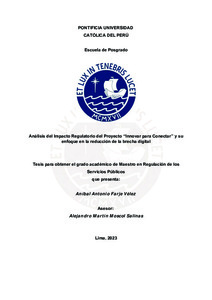| dc.contributor.advisor | Moscol Salinas, Alejandro Martín | |
| dc.contributor.author | Farje Vélez, Aníbal Antonio | |
| dc.date.accessioned | 2023-10-04T17:52:51Z | |
| dc.date.available | 2023-10-04T17:52:51Z | |
| dc.date.created | 2023 | |
| dc.date.issued | 2023-10-04 | |
| dc.identifier.uri | http://hdl.handle.net/20.500.12404/26081 | |
| dc.description.abstract | La industria del servicio de telecomunicaciones en estos últimos tiempos ha
constituido uno de los principales protagonistas en la demanda de cobertura de
internet, ya que el contexto pandemia ha generado mayor demanda del servicio de
telecomunicaciones a tal magnitud de registrar un aumento en el año 2020 de 6,04%
en el índice de producción del sector, según registros del Instituto Nacional de
Estadística e Informática (INEI, posteriormente). Sin embargo, también el sector en
cuestión ha puesto en evidencia la falta de inclusión digital de lo mucho que queda
por hacer para facilitar la conectividad en zonas rurales o zonas de menor demanda.
El Ministerio de Transportes y Comunicaciones (MTC, en adelante) se ha concentrado
alrededor de los 5 últimos años en establecer una fórmula para calcular el cobro del
canon que impulse a las empresas operadoras de telecomunicaciones a contribuir en
la reducción de la brecha digital a través de incremento de infraestructura en zonas
rurales y de preferente interés social del Perú. Si bien es cierto, la última modificación
de la metodología ha logrado un avance, el Estado Peruano aún está lejos de reducir
la brecha de infraestructura por diversos factores, entre ellos la escasez de fluido
eléctrico en diversas localidades.
Por lo tanto, este trabajo tiene por objetivo analizar el impacto regulatorio del proyecto
‘‘Innovar para conectar’’ que plantea modificar la metodología vigente para calcular el
pago del canon por uso del recurso anteriormente mencionado.
A efectos de tener conceptos claros, en primera instancia se tiene el empleo del
análisis de impacto regulatorio (RIA, por sus siglas en inglés) para medir el costobeneficio
del cumplimiento de la norma y consecuentemente se aplicó la metodología
para valorar costos y beneficios de la intervención gubernamental, análisis
multicriterio. Por último, conforme a los resultados obtenidos se realizan
recomendaciones a la metodología vigente. | es_ES |
| dc.description.abstract | The telecommunications service industry in the latter has been one of the main
protagonists in the demand for internet coverage since the pandemic context has
generated greater demand for the telecommunications service to such a magnitude
that it registered an increase in 2020 of 6, 04% in the production index of the sector,
according to records of the National Institute of Statistics and Informatics (INEI, later).
However, the sector in question has also highlighted the lack of digital inclusion of how
much remains to be done to facilitate connectivity in rural areas or areas with less
demand.
The Ministry of Transport and Communications (MTC, hereinafter) has concentrated
around the last 5 years on establishing a formula to calculate the fee charge that
encourages telecommunications operating companies to contribute to reducing the
digital divide through Increasing infrastructure in rural areas and of preferential social
interest in Peru. Although it is true, the latest modification of the methodology has made
progress, the Peruvian State is still far from reducing the infrastructure gap due to
various factors, including the shortage of electricity in various locations.
Therefore, this work proposes as a general objective of study, to analyze the regulatory
impact of the "Innovate to connect" project, which proposes to modify the current
methodology to calculate the payment of the canon for the use of the aforementioned
resource.
In order to have clear concepts, in the first instance, the use of the regulatory impact
analysis (RIA) is used to measure the cost-benefit of compliance with the standard and
consequently the methodology was applied to assess costs and benefits. of
government intervention, multicriteria analysis. Finally, according to the results
obtained, recommendations are made to the current methodology. | es_ES |
| dc.language.iso | spa | es_ES |
| dc.publisher | Pontificia Universidad Católica del Perú | es_ES |
| dc.rights | info:eu-repo/semantics/openAccess | es_ES |
| dc.rights.uri | http://creativecommons.org/licenses/by-nc-sa/2.5/pe/ | * |
| dc.subject | Perú. Ministerio de Transportes y Comunicaciones | es_ES |
| dc.subject | Telecomunicaciones--Legislación--Perú | es_ES |
| dc.subject | Brecha digital--Perú | es_ES |
| dc.title | Análisis del Impacto regulatorio del proyecto ‘‘Innovar para Conectar’’ y su enfoque en la reducción de la brecha digital | es_ES |
| dc.type | info:eu-repo/semantics/masterThesis | es_ES |
| thesis.degree.name | Maestro en Regulación de los Servicios Públicos | es_ES |
| thesis.degree.level | Maestría | es_ES |
| thesis.degree.grantor | Pontificia Universidad Católica del Perú. Escuela de Posgrado | es_ES |
| thesis.degree.discipline | Regulación de los Servicios Públicos | es_ES |
| renati.advisor.dni | 09855438 | |
| renati.advisor.orcid | https://orcid.org/0000-0003-1125-30655 | es_ES |
| renati.author.dni | 45027504 | |
| renati.discipline | 417697 | es_ES |
| renati.juror | Rodríguez González, Abel | es_ES |
| renati.juror | Moscol Salinas, Alejandro Martín | es_ES |
| renati.juror | Pacheco Zevallos, Luis Alejandro | es_ES |
| renati.level | https://purl.org/pe-repo/renati/level#maestro | es_ES |
| renati.type | https://purl.org/pe-repo/renati/type#tesis | es_ES |
| dc.publisher.country | PE | es_ES |
| dc.subject.ocde | https://purl.org/pe-repo/ocde/ford#5.02.01 | es_ES |







